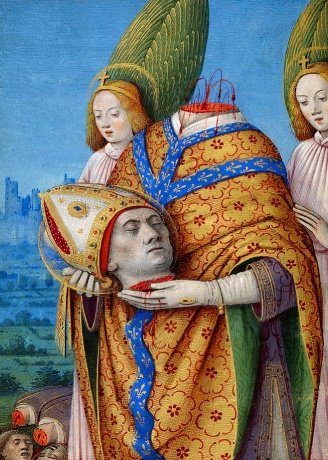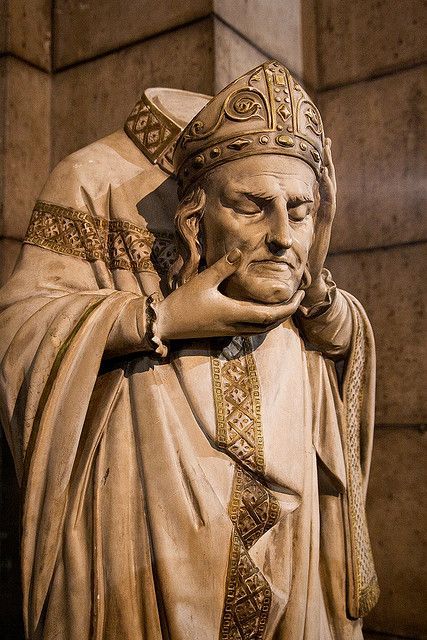
9 October
St. Denis, Bishop, and Companions
(died 250 AD)
Born: Roman Italy, Italy
Died: 250 AD, Montmartre, Paris, France
Attributes: A martyr carrying his severed head in his hands; a bishop’s mitre; city; furnace
Feast: 9 October
Major shrine: Saint Denis Basilica
Patronage: Paris; against frenzy, strife, headaches, hydrophobia, San Dionisio (Parañaque), possessed people
Venerated in: Catholic Church; Anglican Communion; Eastern Orthodox Church
St. Denis, a third-century apostle of Gaul, became first bishop of Paris. He suffered martyrdom there, together with his priest Rusticus and his deacon Eleutherius. He is one of the Fourteen Holy Helpers.
COLLECT PRAYER
O God, who sent Saint Denis and his companions to preach your glory to the nations and strengthened them for their mission with the virtue of constancy in suffering, grant, we pray, that we may imitate them in disdaining prosperity in this world and in being undaunted by any trial. Through our Lord Jesus Christ, your Son, who lives and reigns with you in the unity of the Holy Spirit, God, for ever and ever.
Things to Do:
- Learn more about the Fourteen Holy Helpers and their historical context.
- Bake a French (or Parisian) pastry. Cooking with the Saints by Ernst Schuegraf has 3 recipes for St. Denis — St. Denis Turnovers, Saint Denis Tartlets and Brioche Saint-Denis (Praline Cake).
- Read more about St. Denis:
- See Christian Iconography for some images of St. Denis.
- St. Denis was beheaded c.258 at Montmarte (=mount of martyrs), with his corpse thrown in the River Seine. His followers recovered and buried later that night. The Basilica of St. Denis in Paris is said to have been built over the tomb of St. Denis.
St. Denis
St. Denis was born in Italy. In 250 he was sent to France with six other missionary bishops by Pope Fabian. Denis became the first bishop of Paris. He was beheaded in 258 with the priest Rusticus and the deacon Eleutherius at Catulliacum, now Saint-Denis. One of the many legends about his torture and death was that his body carried his severed head some distance from his execution site. St. Denis is one of the Fourteen Holy Helpers who was invoked particularly in the Middle Ages against the Black Plague. See August 8 for more information.
Patronage: against frenzy; against strife; against headaches; against diabolical possession; against rabies; against hydrophobia; possessed people; France; Paris, France.
Symbols and Representation: beheaded bishop carrying his head — sometimes a vine growing over his neck; mitered head in his hand or on book; white chasuble; tree or stake; sword; Our Lord with chalice and host.
Source: CATHOLIC CULTURE
Bishop of Paris, and martyr
Born in Italy, nothing is definitely known of the time or place, or of his early life. His feast is kept on 9 October. He is usually represented with his head in his hands because, according to the legend, after his execution the corpse rose again and carried the head for some distance. That, however, while still very young he was distinguished for hisvirtuous life, knowledge of sacred things, and firm faith, is proved by the fact that Pope Fabian (236-250) sent him with some other missionary bishops to Gaul on a difficult mission. The Church of Gaul had suffered terribly under the persecution of the Emperor Decius and the new messengers of Faith were to endeavour to restore it to its former flourishing condition. Denis with his inseparable companions, the priest Rusticus and the deacon Eleutherius, arrived in the neighbourhood of the present city of Paris and settled on the island in the Seine. The earliest document giving an account of his labours and of his martyrdom (Passio SS. Dionsyii, Rustici et Eleutherii), dating from the end of the sixth or the beginning of the seventh century and wrongly attributed to the poet Venantius Fortunatus, is interwoven with much legend, from which, however, the following facts can be gleaned.

On the island in the Seine Denis built a church and provided for a regular solemnization of the Divine service. His fearless and indefatigable preaching of the Gospel led to countless conversions. This aroused the envy, anger and hatred of the heathen priests. They incited the populace against the strangers and importuned the governor Fescenninus Sisinnius to put a stop by force to the new teaching. Denis with his two companions were seized and as they persevered in their faith were beheaded (about 275) after many tortures. Later accounts give a detailed description of the confessors’ sufferings. They were scourged, imprisoned, racked, thrown to wild beasts, burnt at the stake, and finally beheaded. Gregory of Tours simply states: “Beatus Dionysius Parisiorum episcopus diversis pro Christi nomine adfectus poenis praesentem vitam gladio immente finivit” (Hist. Franc. I, 30). The bodies of the three holy martyrs received an honourable burial through the efforts of a pious matron named Catulla and a small shrine was erected over their graves. This was later on replaced by a beautiful basilica (egregium templum) which Venantius celebrated in verse (Carm. I, ii).
From the reign of King Dagobert (622-638) the church and the Benedictine monastery attached to it were more and more beautifully adorned; the veneration of St. Denis became by degrees a national devotion, rulers and princes vying with one another to promote it. This development is due in no small degree to an error prevailing throughout the Middle Ages, which identified St. Denis of Paris with St. Dionysius the Areopagite, and with the Pseudo-Dionysius, the composer of the Areopagitic writings. The combining of these three persons in one was doubtless effected as early as the eighth or perhaps the seventh century, but it was only through the “Areopagitica” written in 836 byHilduin, Abbot of Saint-Denis, at the request of Louis the Pious, that this serious error took deep root. The investigations of Launoy first threw doubt on the story and the Bollandist de Bye entirely rejected it. Hilduin was probably deceived by the same apocryphal Latin and Greek fictions. The possession of the Areopagitic writings (since 827 in Saint-Denis) strengthened his conviction of this truth. Historiographers of the present day do not dispute this point. All attempts of Darras, Vidieu, C. Schneider, and others to throw some light on the subject have proved fruitless.
(Taken from Catholic Encyclopedia)
Source: EWTN
[excerpt from Wikipedia]
Martyrdom of St Denis of Paris
Denis and his companions were so effective in converting people that the pagan priests became alarmed over their loss of followers. At their instigation, the Roman Governor arrested the missionaries. After a long imprisonment, Denis and two of his clergy were executed by beheading[4] on the highest hill in Paris (now Montmartre), which was likely to have been a druidic holy place. The martyrdom of Denis and his companions is popularly believed to have given the site its current name, derived from the Latin Mons Martyrum “The Martyrs’ Mountain”,[1] although the name is possibly derived from Mons Mercurii et Mons Martis, Hill of Mercury and Mars.[6] After his head was cut off, Denis is said to have picked it up and walked several miles from the summit of the hill, preaching a sermon the entire way, making him one of many cephalophores in hagiology. Of the many accounts of this martyrdom, this is noted in detail in the Golden Legend and in Butler’s Lives Of The Saints.[7] The site where he stopped preaching and actually died was marked by a small shrine that developed into the Basilica of Saint-Denis, which became the burial place for the kings of France. Another account has his corpse being thrown into the Seine, but recovered and buried later that night by his converts.[2][4]